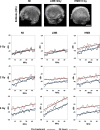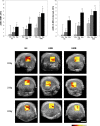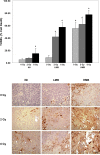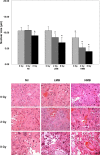Quantitative ultrasound imaging of therapy response in bladder cancer in vivo
- PMID: 27226985
- PMCID: PMC4872650
- DOI: 10.18632/oncoscience.302
Quantitative ultrasound imaging of therapy response in bladder cancer in vivo
Abstract
Background and aims: Quantitative ultrasound (QUS) was investigated to monitor bladder cancer treatment response in vivo and to evaluate tumor cell death from combined treatments using ultrasound-stimulated microbubbles and radiation therapy.
Methods: Tumor-bearing mice (n=45), with bladder cancer xenografts (HT- 1376) were exposed to 9 treatment conditions consisting of variable concentrations of ultrasound-stimulated Definity microbubbles [nil, low (1%), high (3%)], combined with single fractionated doses of radiation (0 Gy, 2 Gy, 8 Gy). High frequency (25 MHz) ultrasound was used to collect the raw radiofrequency (RF) data of the backscatter signal from tumors prior to, and 24 hours after treatment in order to obtain QUS parameters. The calculated QUS spectral parameters included the mid-band fit (MBF), and 0-MHz intercept (SI) using a linear regression analysis of the normalized power spectrum.
Results and conclusions: There were maximal increases in QUS parameters following treatments with high concentration microbubbles combined with 8 Gy radiation: (ΔMBF = +6.41 ± 1.40 (±SD) dBr and SI= + 7.01 ± 1.20 (±SD) dBr. Histological data revealed increased cell death, and a reduction in nuclear size with treatments, which was mirrored by changes in quantitative ultrasound parameters. QUS demonstrated markers to detect treatment effects in bladder tumors in vivo.
Keywords: quantitative ultrasound; radiation therapy; ultrasound; vascular disrupting agents.
Conflict of interest statement
The authors declare no conflict of interest.
Figures





Similar articles
-
Quantitative ultrasound characterization of therapy response in prostate cancer in vivo.Am J Transl Res. 2021 May 15;13(5):4437-4449. eCollection 2021. Am J Transl Res. 2021. PMID: 34150025 Free PMC article.
-
Assessment of tumor response to radiation and vascular targeting therapy in mice using quantitative ultrasound spectroscopy.Med Phys. 2015 Aug;42(8):4965-73. doi: 10.1118/1.4926554. Med Phys. 2015. PMID: 26233222
-
Noninvasive Evaluation of Breast Tumor Response to Combined Ultrasound-Stimulated Microbubbles and Hyperthermia Therapy Using Quantitative Ultrasound-Based Texture Analysis Method.J Ultrasound Med. 2024 Jan;43(1):137-150. doi: 10.1002/jum.16347. Epub 2023 Oct 24. J Ultrasound Med. 2024. PMID: 37873733
-
Implementation of Non-Invasive Quantitative Ultrasound in Clinical Cancer Imaging.Cancers (Basel). 2022 Dec 16;14(24):6217. doi: 10.3390/cancers14246217. Cancers (Basel). 2022. PMID: 36551702 Free PMC article. Review.
-
Quantitative ultrasound imaging of soft biological tissues: a primer for radiologists and medical physicists.Insights Imaging. 2021 Sep 9;12(1):127. doi: 10.1186/s13244-021-01071-w. Insights Imaging. 2021. PMID: 34499249 Free PMC article. Review.
Cited by
-
Quantitative Ultrasound for Evaluation of Tumour Response to Ultrasound-Microbubbles and Hyperthermia.Technol Cancer Res Treat. 2023 Jan-Dec;22:15330338231200993. doi: 10.1177/15330338231200993. Technol Cancer Res Treat. 2023. PMID: 37750232 Free PMC article.
-
Preclinical Applications of Multi-Platform Imaging in Animal Models of Cancer.Cancer Res. 2021 Mar 1;81(5):1189-1200. doi: 10.1158/0008-5472.CAN-20-0373. Epub 2020 Dec 1. Cancer Res. 2021. PMID: 33262127 Free PMC article. Review.
-
Ultrasound irradiation in the presence of microbubbles may enhance the antitumor effect of chemotherapeutic agents against bladder cancer.J Cancer. 2025 Jan 1;16(2):368-381. doi: 10.7150/jca.100846. eCollection 2025. J Cancer. 2025. PMID: 39744489 Free PMC article.
-
Ultrasound-stimulated microbubble radiation enhancement of tumors: Single-dose and fractionated treatment evaluation.PLoS One. 2020 Sep 25;15(9):e0239456. doi: 10.1371/journal.pone.0239456. eCollection 2020. PLoS One. 2020. PMID: 32976517 Free PMC article.
-
Microbubble-based enhancement of radiation effect: Role of cell membrane ceramide metabolism.PLoS One. 2017 Jul 26;12(7):e0181951. doi: 10.1371/journal.pone.0181951. eCollection 2017. PLoS One. 2017. PMID: 28746357 Free PMC article.
References
-
- James ND, Hussain SA, Hall E, Jenkins P, Tremlett J, Rawlings C, Crundwell M, Sizer B, Sreenivasan T, Hendron C, Lewis R, Waters R, Huddart RA, Investigators BC. Radiotherapy with or without chemotherapy in muscle-invasive bladder cancer. N Engl J Med. 2012;366:1477–1488. - PubMed
-
- Stenzl A, Cowan NC, De Santis M, Kuczyk MA, Merseburger AS, Ribal MJ, Sherif A, Witjes JA, European Association of U Treatment of muscle-invasive and metastatic bladder cancer: update of the EAU guidelines. Eur Urol. 2011;59:1009–1018. - PubMed
-
- Pectasides D, Pectasides M, Nikolaou M. Adjuvant and neoadjuvant chemotherapy in muscle invasive bladder cancer: literature review. Eur Urol. 2005;48:60–67. discussion 67-68. - PubMed
-
- Wilson WR, Li AE, Cowan DS, Siim BG. Enhancement of tumor radiation response by the antivascular agent 5,6-dimethylxanthenone-4-acetic acid. Int J Radiat Oncol Biol Phys. 1998;42:905–908. - PubMed
LinkOut - more resources
Full Text Sources
Other Literature Sources

